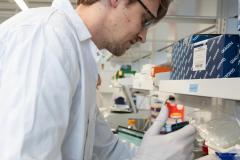 For patients with type 1 diabetes (T1D), pancreatic cell transplants are a source of hope. This experimental treatment can eliminate the need for regular insulin injections, effectively curing diabetes — but they’re not an option for most people. That’s because the research needed to refine the procedure and make it available to more people – including kids – is limited by the availability of donor cells; two pancreases from deceased donors are needed to harvest enough cells for one procedure.
For patients with type 1 diabetes (T1D), pancreatic cell transplants are a source of hope. This experimental treatment can eliminate the need for regular insulin injections, effectively curing diabetes — but they’re not an option for most people. That’s because the research needed to refine the procedure and make it available to more people – including kids – is limited by the availability of donor cells; two pancreases from deceased donors are needed to harvest enough cells for one procedure.
“While promising, pancreatic cell transplants can’t yet help children facing a lifetime of living with diabetes and the risk of dangerous complications that come with it,” says Dr. Francis Lynn, an investigator with the Canucks for Kids Fund Childhood Diabetes Laboratories at BC Children’s Hospital.
“We’re working to understand exactly how insulin-producing cells develop with the goal of eventually growing these cells in the lab,” said Dr. Lynn. “Once perfected, this technique could eliminate the need to harvest these cells from donors and further the research needed to make these transplants an option for patients of all ages.”
In their latest study, published in Stem Cell Reports, Dr. Lynn’s team analyzed the genetic changes that occur when individual cells become specialized insulin-producing cells called beta cells.
“Previous research provided scientists with a 10,000-foot overview of how the pancreas develops,” says Dr. Lynn. “But what’s been missing is an understanding of the molecular changes that are important at the single-cell level. This study gives us a ‘google street view’ to map out how these cell populations develop.”
In addition to publishing the data in the study, the team also created a website as a resource for scientists around the world to better understand how these cells develop and how to achieve the goal of creating a key supply of insulin for patients.
“Understanding the genetic changes at the individual cell level is key. Using the latest technology, we identified several genes that may be important in determining how cells develop into hormone producers,” says Dr. Lynn.
“If we had lumped all the cells together, instead of taking a cell-by-cell approach, then the genetic expression we captured might have flown under the radar.”
In Canada, 33,000 school age children have T1D and kids under five years are the fastest growing group of new cases.
T1D occurs when the body’s immune system mistakenly attacks and destroys the insulin-producing cells in the pancreas. Without insulin, the body is unable to control blood sugar levels, leading to a constant insulin injections, regular blood tests and careful meal planning.
Although insulin injections have turned T1D from a death sentence into a chronic illness, insulin is not a cure. People with T1D are still at risk for serious health problems including kidney failure, blindness, nerve damage, amputations, heart attack, and stroke. By some estimates, having T1D reduces a person’s life expectancy by 15 years.
“There is some way to go before beta cells produced in the lab are safe to use for transplantation,” says Dr. Lynn. “But this study provides an important tool for diabetes researchers to better understand how beta cells develop and work towards the day when we can offer children with diabetes a lifelong cure.”
Dr. Lynn is an associate professor with the Departments of Surgery and Cellular & Physiological Sciences at the University of British Columbia (UBC).
This research was funded by the Canadian Foundation for Innovation and the Stem Cell Network.
Dr. Lynn is supported by the Michael Smith Foundation for Health Research, the Canadian Diabetes Association, and BC Children’s Hospital Foundation.
Nicole Krentz, study co-author, was at the time a UBC PhD candidate working with Dr. Lynn, received fellowship support from the CIHR-BC Transplantation Trainee Program, the BC Children’s Hospital Research Institute, UBC and the National Science and Engineering Research Council of Canada. She has since graduated, and is now continuing her studies at the University of Oxford.
Read More:
Krentz, N.A., Lee, M. Y., Xu, E. E., Sproul, S. L., Maslova, A., Sasaki, S., Lynn, F. C. (2018). Single-Cell Transcriptome Profiling of Mouse and hESC-Derived Pancreatic Progenitors. Stem Cell Reports, 11(6), 1551-1564.
DOI: https://doi.org/10.1016/j.stemcr.2018.11.008




